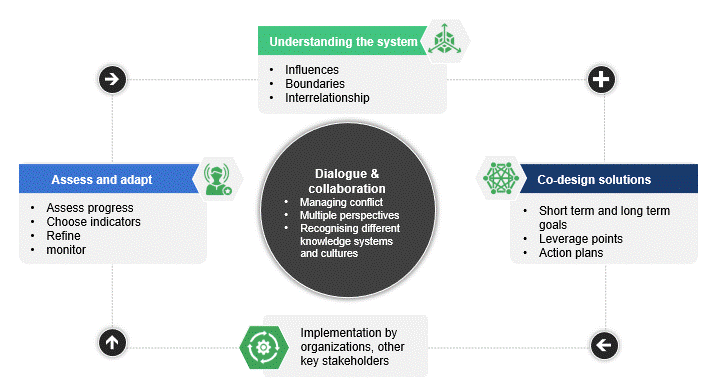An introduction to systems thinking and systemic design – concepts and tools
Complexity is a core feature of most policy issues today. Climate change, public health, catchment (watershed) management, conservation, income inequality and poverty today are known to be wicked or messy problems. These wicked problems are characterized by complexity, uncertainty, interdependence and multiple social perspectives. Recognition of this complexity challenge has led to a growing interest in systems thinking and other collaborative and system-based approaches such as design thinking and systemic design.
This post and included slide set (Fig. 1) provide an introduction to systems thinking and systemic design. It provides the outline for an interactive workshop that Margaret Kilvington (ISREF) and I developed to support agency staff and others wanting to explore systems thinking and systemic design. It builds directly on the experiences we have had working in the natural resource management and sustainable development sectors and also looks briefly at the range of concepts and tools might be used with these approaches. The presentation is provided below as an inline version, along with a following summary of the content. A downloadable PDF version of the presentation is available. The presentation covers 5 main topic areas:
- Context: Why decision-makers are moving towards systems-based approaches
- Systems thinking basics
- Systemic design – linking systems thinking and design
- Tools and methods that support systems thinking and systemic design in practice
- Nurturing and supporting systems thinking in your team or organisation
Figure 1: Inline presentation – An introduction to systems thinking and systemic design – concepts and tools. This presentation is also available as a PDF download.
Successfully tackling wicked problems requires a general understanding that there are no quick fixes and simple solutions. They require the use of systems thinking approaches that simultaneously help those involved to simultaneously recognise the big picture and acknowledge the interrelationships among the wider range of causal factors underlying them. Addressing these complex challenges requires the development of innovative, comprehensive solutions that can be modified in the light of experience and on-the-ground feedback. They require a range of stakeholders (often at different decision-making levels) to work together in a more coordinated and collaborative manner.
Systems thinking and systemic design benefits
Greater use of systems thinking and systemic design approaches enable us to do a number of things more effectively such as:
- Change our thinking to match the interconnected, dynamic complexity of our communities and their environments.
- Communicate with others to create new ways of thinking and seeing – and develop shared understanding.
- Become more aware of the potential for unintended consequences of our actions.
- Expand the choices available to us and identify those choices where we can develop significant leverage.
- Harness social learning processes to help us develop a shared understanding and take action collectively
Systems thinking is an approach to integration that is based on the belief that the component parts of a system will act differently when isolated from the system’s environment or other parts of the system. Standing in contrast to positivist and reductionist thinking, systems thinking sets out to view systems in a holistic manner. Consistent with systems philosophy, systems thinking concerns an understanding of a system by examining the linkages and interactions between the elements that comprise the whole of the system. Systems thinking in practice encourages us to explore inter-relationships (context and connections), perspectives (each actor has their own unique perception of the situation) and boundaries (agreeing on scope, scale and what might constitute an improvement). It is a mental framework to support problem solving and expand the constructive choices available to us. Hence the growing interest in learning to strengthen systems thinking practices, and manage organisational cultures that encourage its use in both problem structuring and solution design.
Systems thinking can just be used to help understand or analyse a situation. However, multiple stakeholder groups can be involved in the systems thinking process and a subsequent design thinking process – which is outcome focused, and can be seen to cover a number of different phases. Systemic design – Integrating the mindsets and toolsets of systems thinking and design thinking to encourage learning and innovative systems change in this way is often referred to as systemic design.
Adaptive management and policy setting
For example four key components in a typical adaptive management/policy setting process may include:
- Understanding the issue and the wider context in which it is sited. This needs to include inquiring into how the different stakeholders involved experience things.
- Co-designing action and assessment plans. Needs to engage stakeholders around aims, assumptions and implications – and collectively identify constructive leverage points and how to evaluate and assess progress.
- Contributing to the wider operational implementation process
- Learning and refining over time. Involving stakeholders in learning-based adaptive management – “so what?” and “what now?” discussions that follow on from monitoring, evaluation and reflection.
These four components can be broadly be seen as comprising an iterative and experiential learning cycle. However, in a complex setting with multiple different social perspectives and works streams involved each approach is best carried out in ways that support dialogue and collaboration among the different parties involved (see below figure). At the same time, using a systems approach implies a recognition that complex systems are continually evolving – so we don’t need to know everything about the system before engaging in solution finding activities.

The tools and methods to be used in these approaches can also be grouped by these five components. Understanding the system includes tools for making the different systems and their component visible (maps, rich pictures, timelines, computer models, etc.), and identifying leverage points to improve things. It also involves finding appropriate ways of making sense of these via problem structuring and other strategic planning tools. Co-designing solutions invites those involved to build on that systems understanding and use design thinking and related methods to find pathways forward. There are a range of approaches that can be used within a collaborative design approach to do this, including theory of change (ToC), logic modelling, scenario planning, etc. Implementation – especially requiring a range of different activity streams – can be guided by collaborative planning and ToC approaches. Evaluation and reflection play an important role in adaptive management, and feedback loops are supported by the selection of good evaluation processes, monitoring and indicator selection. In all of these areas involving the right people is important. In turn, this will require many policy and operational teams to move beyond their current focus on technical expertise to also include people with demonstrated skills and expertise in surfacing other perspectives, listening and actively engaging with a range of partners.
Implementing new approaches in practice
The last topic area reminds us that its often hard to embed new ways of thinking and operation in the practical realities of our everyday work environments and cultures. Common challenges often include things like: the perception that learning (collaboration and dialogue) takes too long; that there are often too few people with the skillsets and resources required to follow through; the perception that there may be a lack of safe spaces for groups to work in this different way; etc. Responses to these challenges point to the importance of creating a learning organisation where people continually expand their capacity to create the results they truly desire, new and expansive patterns of thinking are nurtured, collective aspiration is set free, and people are continually learning to see the bigger picture together.
An independent systems scientist, action research practitioner and evaluator, with 30 years of experience in sustainable development and natural resource management. He is particularly interested in the development of planning, monitoring and evaluation tools that are outcome focused, and contribute towards efforts that foster social learning, sustainable development and adaptive management.

0 Comments on “An introduction to systems thinking and systemic design – concepts and tools”